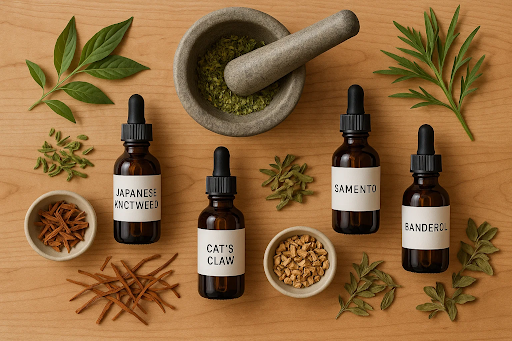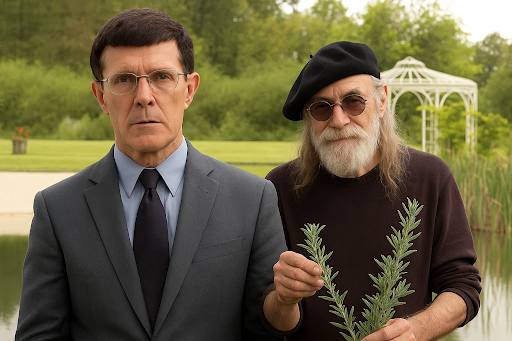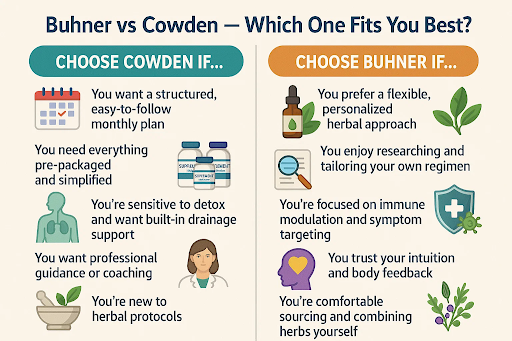
If you have been battling chronic Lyme disease, you already know the journey is not linear and also the antibiotics alone does not always bring relief. According to studies, 10-20% of Lyme patients experience symptoms even after the treatment– Post-Treatment Lyme Disease Syndrome (PTLDS).
People are exploring plant- based healing protocols and are diving in for a holistic approach. Two renowned protocols are– Buhner Protocol and Cowden Protocol. Each of these are grounded by science, personal, and emphasized in a step- by- step approach.
Now the question is definitely not “Which one is better?”
It is “Which one aligns with your body, mindset, and lifestyle?”
Meet the Masters: Stephen Buhner & Dr. Lee Cowden

When it comes to herbal healing for Lyme disease, two names rise to the top— Stephen Harrod Buhner and Dr. Lee Cowden.
Their approach, background, and healing philosophies are remarkably different.
Stephen Harrod Buhner: The Herbalist Mystic of Lyme Healing
- Stephen Buhner was a renowned herbalist, author, and researcher with a deep knowledge of nature. He works with the body’s innate healing capacity and attacks pathogens.
- Buhner believed that chronic Lyme disease involves not just infection– aids restores balance, minimizes inflammation, and supports the body long- term with herbs.
- His books, especially“Healing Lyme”- have become essential reading for patients and practitioners alike.
- So Buhner’s Protocol is modular, flexible, and intuitive in nature. It allows the personalization of the symptoms.
Dr. Lee Cowden: The Physician-Scientist of Integrative Lyme Care
- Dr. Lee Cowden is a cardiologist. He invented the Cowden Support Program (CSP) for Lyme disease. His approach is deeply detoxification- focused, addressing co-infections, toxins, and immune blockages.
- Dr. Cowden sees Lyme disease as a multi- systemic illness. His approach is deeply focused on antimicrobials, detox agents, and energetic therapies.
The Cowden Protocol is standardized, month-by-month, and widely used by Lyme-literate practitioners globally. It’s especially appealing to patients looking for step-by-step guidance, practitioner supervision, and support for complex, whole-body illness.
Herbs and Remedies in Focus

Buhner’s Key Botanicals:
- Japanese Knotweed: Anti-inflammatory, antimicrobial, neuroprotective. It contains resveratrol which crosses the blood- brain barrier and aids in calming inflammatory responses.
- Andrographis paniculata: Broad spectrum antimicrobial and immune stimulator. Known for fighting bacteria, viruses, and parasites. Commonly used for fatigue, body pain, and co- infections.
- Cat’s Claw: main properties are immunomodulation, antimicrobial, and anti- inflammatory properties.
Cowden’s Core Formulas:
- Samento: It has immunomodulatory and antimicrobial properties. It is central to Cowden’s system for controlling Borrelia and co- infections.
- Banderol: It has antibacterial, and antifungal properties. It works in the gut and bloodstream to combat infections.
Detoxification: Parsley, burbur, and magnesium malate. Focuses on clearing toxins as you kill microbes and support healing.
Buhner vs Cowden: A Side-by-Side Comparison Chart
|
Feature |
Buhner Protocol |
Cowden Protocol |
|
Core Philosophy |
Kill pathogens, detox the body, reset immunity |
Kill pathogens, detox the body, reset immunity |
|
Approach |
Flexible, intuitive, symptom-based |
Structured, monthly rotating protocol |
|
Main Focus |
Inflammation control, immune modulation, tissue repair |
Antimicrobial action, detoxification, biofilm busting |
|
Detox Strategy |
Gentle detox via lymph/liver herbs (Red Root, Milk Thistle) |
Central focus: Burbur, Parsley, Sparga, binders |
|
Customization |
High – tailored to patient’s unique symptoms |
Low – standardized schedule and dosages |
|
Ease of Use |
Requires self-education or practitioner familiar with Buhner’s work |
Easier for DIY with guidance, or use under practitioner supervision |
|
Supplement Format |
Individual herbs (powders, tinctures, capsules – mixed from various suppliers) |
NutraMedix tincture drops (pre-formulated, travel-friendly) |
|
Length of Protocol |
Ongoing, patient-paced – no fixed timeline |
6–9 months minimum (standardized timeline) |
|
Requires Practitioner? |
Needed |
Recommended, though many DIY it with online support |
|
Addresses Co-Infections? |
Yes – with added herbs. Aids in Lyme mainly |
Yes – specific products for Babesia, Lyme |
Choosing Your Path: Questions to Ask Yourself

- How much structure or time do I need?
- Choose Cowden if you thrive with clear schedules.
- Choose Buhner if you’re more intuitive and flexible in your healing approach.
- What’s my level of emotional and physical energy?
- Choose Buhner if you're burned out or highly sensitive.
- Choose Cowden if you're ready to actively engage in daily detox and antimicrobial rotations.
- What is the intensity of my symptoms?
- Choose Buhner if you are focusing on calming neurological symptoms.
- Choose Cowden if there are co- infections, toxic buildup.
- What is my budget and how is the accessibility?
- Choose Buhner if you want to buy individual herbs at an affordable rate and accessible.
- Choose Cowden if you want a pre- made professional sourced kit.
- What healing philosophy do I follow?
- Choose Buhner if you believe in working on the body gently and restoring balance gradually.
- Choose Cowden if you want a more medical, antimicrobial and heavy detoxification route.
- Am I ready for the journey on an emotional level?
- Choose Buhner if you want something gentle, more intuitive and slow progress.
- Choose Cowden if you are mentally prepared for intensive healing.
Conclusion
- Healing from Lyme disease is not always about killing the bacteria. It is a fight to reconstruct the immunity, detox subtly, and restore energy.
- Remember, this is your healing journey—not anyone else's.You can start with one and adapt. You can mix and match based on how your body responds. What matters most is that you stay curious, consistent, and kind to yourself.
- Because healing isn’t just possible—it’s personal. And the right path is the one you walk with understanding and trust.
What’s Next for You?
Ready to explore a more complete path to recovery? Join the Lyme Support Network Community.
References
- Zhang Y, Zhang J, Hoagland-Hanson A, et al. Evaluation of selected botanicals and micronutrients against stationary phase Borrelia burgdorferi. Front Med (Lausanne). 2020;7:6. doi:10.3389/fmed.2020.00006. Available from: Link
- Schwartz, A.M.; Hinckley, A.F.; Mead, P.S.; Hook, S.A.; Kugeler, K.J. Surveillance for Lyme Disease—United States, 2008–2015. MMWR Surveill. Summ.2017, 66, 1–12.Link
- Shor SM, Schweig SK; Feng J, Leone J, Schweig S, Zhang Y. The Use of Natural Bioactive Nutraceuticals in the Management of Tick‑Borne Illnesses. Microorganisms. 2023;11(7):1759. Link
- Stephen Harrod Buhner (1952–2022) was a renowned herbalist and author whose book has influenced thousands.Link







